In Florida’s vibrant wetlands and coastal havens, a dazzling array of heron species graces the landscape. Witness the allure of these majestic birds as we delve into the realm of the 12 Herons of Florida.
From the iconic Great Egret with its snowy plumage to the stealthy Black-crowned Night Heron prowling the shadows, each heron species contributes to the rich avian tapestry of the Sunshine State.
Join us on a journey through marshes, sanctuaries, and coastal oases to discover these elegant birds’ unique characteristics, habitats, and behaviors.
From the regal Great Blue Heron to the petite yet captivating Least Bittern, the 12 Herons of Florida embody the ecological richness and diversity of one of America’s most biodiverse regions. Stay sharp.
12 Herons of Florida
Check out the avian wonders of Florida’s diverse ecosystems through a captivating journey into the lives of its magnificent heron species.
Each bird paints a vibrant portrait of resilience and adaptation in the wetlands, from the elegant Great Egret to the elusive Least Bittern.
Join us in exploring the unique characteristics and contributions of these feathered residents.
1. Great Egret
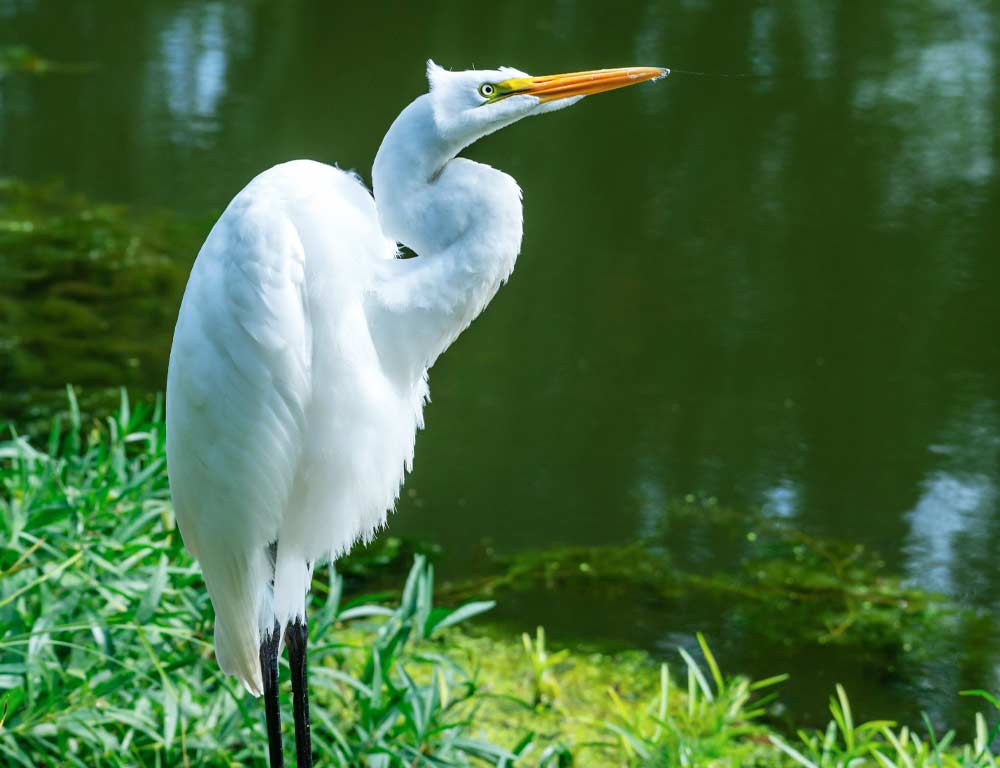
- Scientific name: Ardea alba
- Category: wading bird
- Population: stable
- Life span: 15 years
- Size: 37-41 inches
- Weight: 2.2 pounds
- Food: primarily fish, but also amphibians, reptiles, small mammals, and insects
- Wingspan: 51-57 inches
- Status: least concern
The Great Egret, with its stunning all-white plumage and distinctive long legs and neck, is a common sight in Florida’s wetlands.
This majestic bird is known for its patient and stealthy hunting behavior, standing motionless in shallow waters and using its sharp bill to snatch prey.
Its diet primarily consists of fish, but it is an opportunistic feeder, also consuming amphibians, reptiles, small mammals, and insects. The Great Egret’s wingspan and elegant appearance make it a remarkable bird to observe in its natural habitat.
With a stable population and a lifespan of up to 15 years, the Great Egret plays a vital role in the ecosystem, contributing to the balance of aquatic life.
2. Cattle Egret
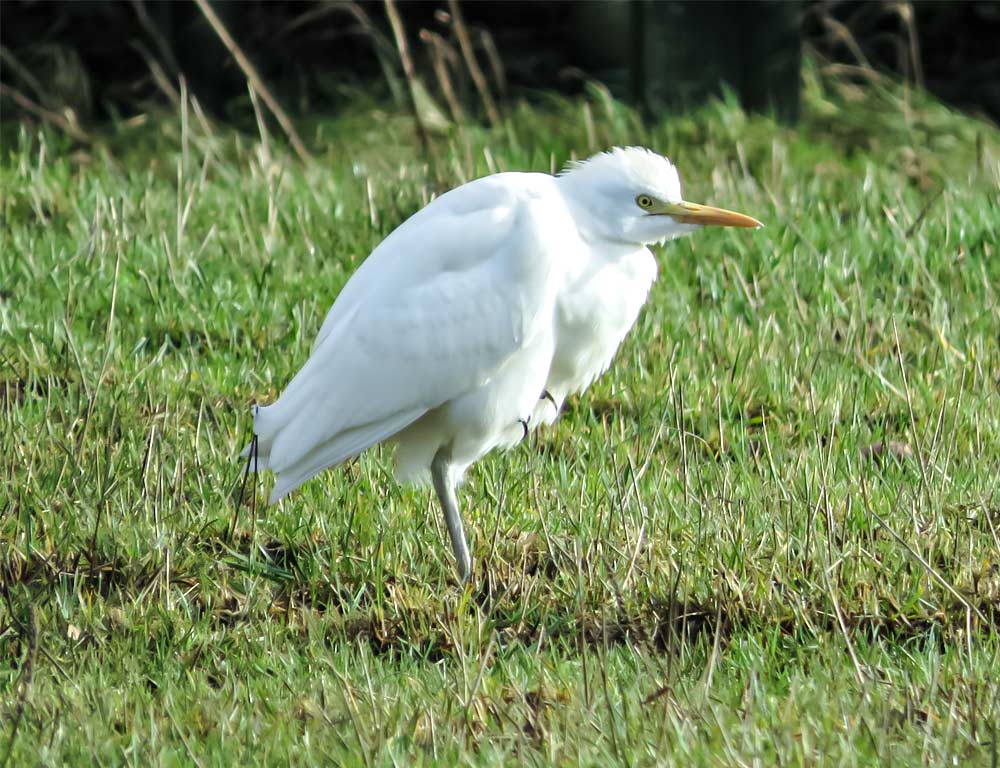
- Scientific name: Bubulcus ibis
- Category: wading bird
- Population: Increasing
- Life span: 10 years
- Size: 18-22 inches
- Weight: 0.9 pounds
- Food: insects, especially ticks and flies, found near cattle and other large mammals
- Wingspan: 35 inches
- Status: least concern
The Cattle Egret is a small, stocky heron often found in close proximity to cattle and other large mammals. This bird has adapted to a commensal relationship with these animals, feeding on insects disturbed by their movements.
With a diet primarily consisting of ticks and flies, the Cattle Egret helps control pests, making it a beneficial species for both the environment and agriculture.
Despite its small size, the Cattle Egret has a notable wingspan and displays agile flying capabilities. With an increasing population and a lifespan of up to 10 years, the Cattle Egret continues to thrive in Florida’s diverse ecosystems.
3. Green Heron
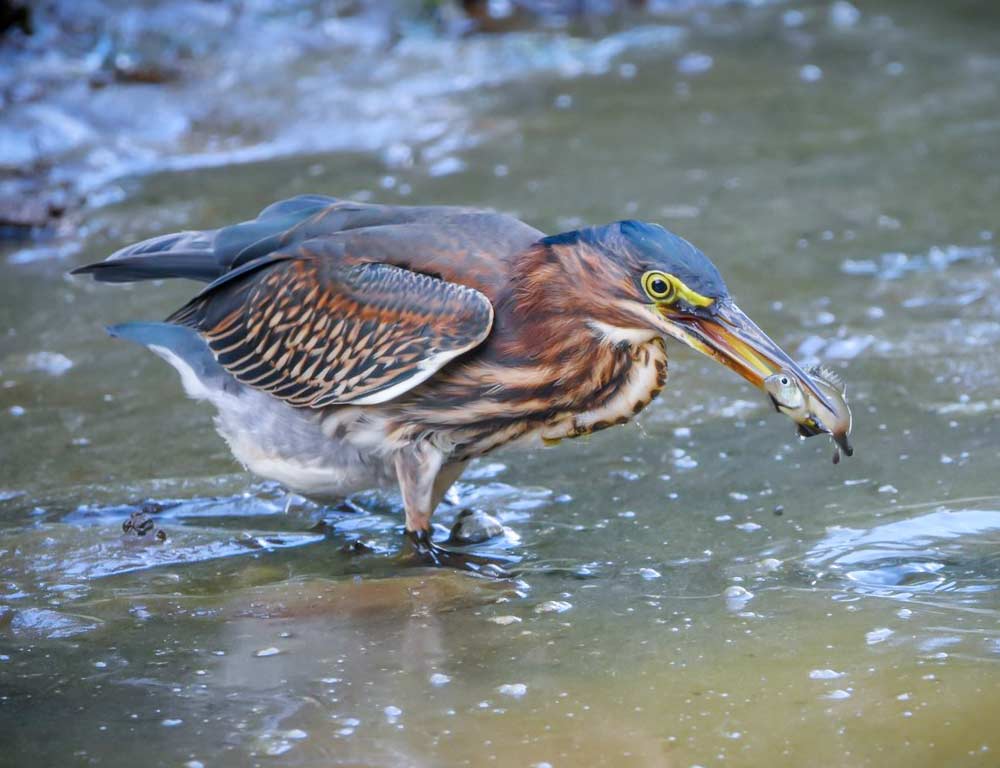
- Scientific name: Butorides virescens
- Category: small heron
- Population: stable
- Life span: 7 years
- Size: 16-22 inches
- Weight: 0.5 pounds
- Food: fish, insects, amphibians, and small mammals
- Wingspan: 26 inches
- Status: least concern
The Green Heron is a compact and colorful bird, easily identifiable by its deep greenish-black cap and striking chestnut-colored neck. This species is often found in freshwater habitats, where it displays remarkable fishing skills.
Using its sharp bill and quick reflexes, the Green Heron preys on fish, insects, amphibians, and small mammals. Despite its smaller size and wingspan, this heron exhibits agility and dexterity while navigating through dense vegetation.
With a stable population and a lifespan of up to 7 years, the Green Heron contributes to the biodiversity of Florida’s wetlands, showcasing adaptability and resourcefulness in its hunting and foraging behaviors.
4. Black-crowned Night Heron
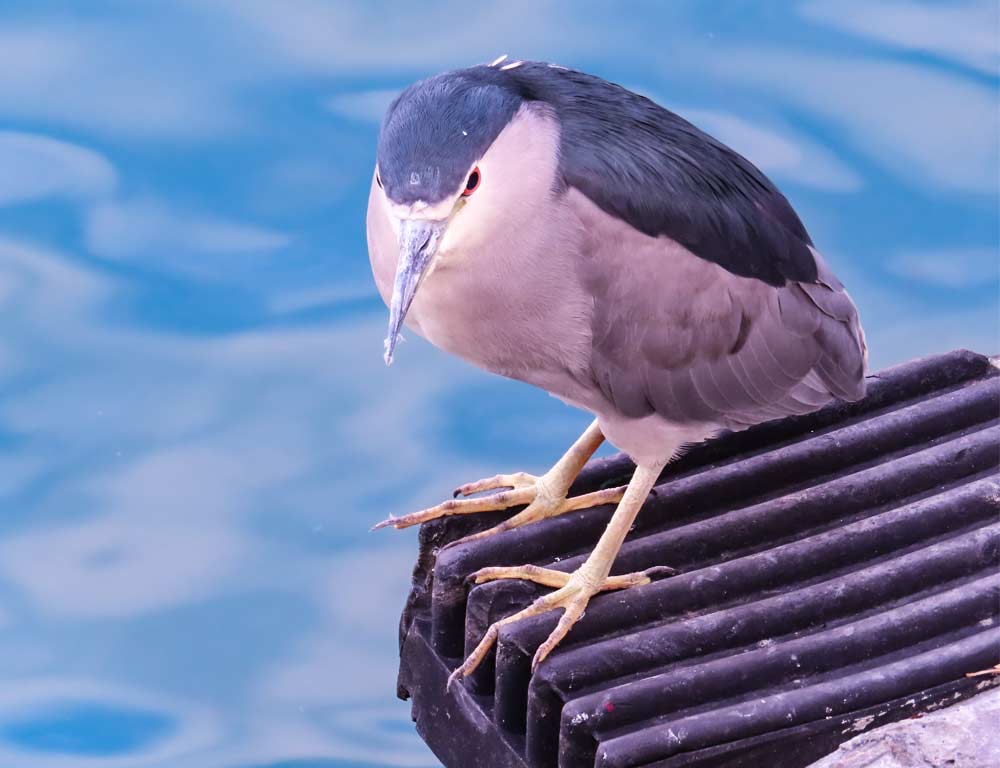
- Scientific name: Nycticorax nycticorax
- Category: medium-sized heron
- Population: stable
- Life span: 20 years
- Size: 23-28 inches
- Weight: 1.5-2.2 pounds
- Food: fish, crustaceans, insects, amphibians, and small mammals
- Wingspan: 44-47 inches
- Status: least concern
The Black-crowned Night Heron, with its distinct black cap and reddish eyes, is a primarily nocturnal heron species found in various wetland habitats.
Its feeding habits extend beyond nighttime, as it also opportunistically hunts during daylight hours.
With a diverse diet, including fish, crustaceans, insects, amphibians, and small mammals, the Black-crowned Night Heron showcases adaptability in its foraging behaviors. It is known for its patient stalking and slow movements, waiting for prey to come within striking distance.
With a stable population and a lifespan of up to 20 years, this heron contributes to the ecological balance of Florida’s wetlands, particularly during crepuscular and nocturnal periods.
5. Great Blue Heron
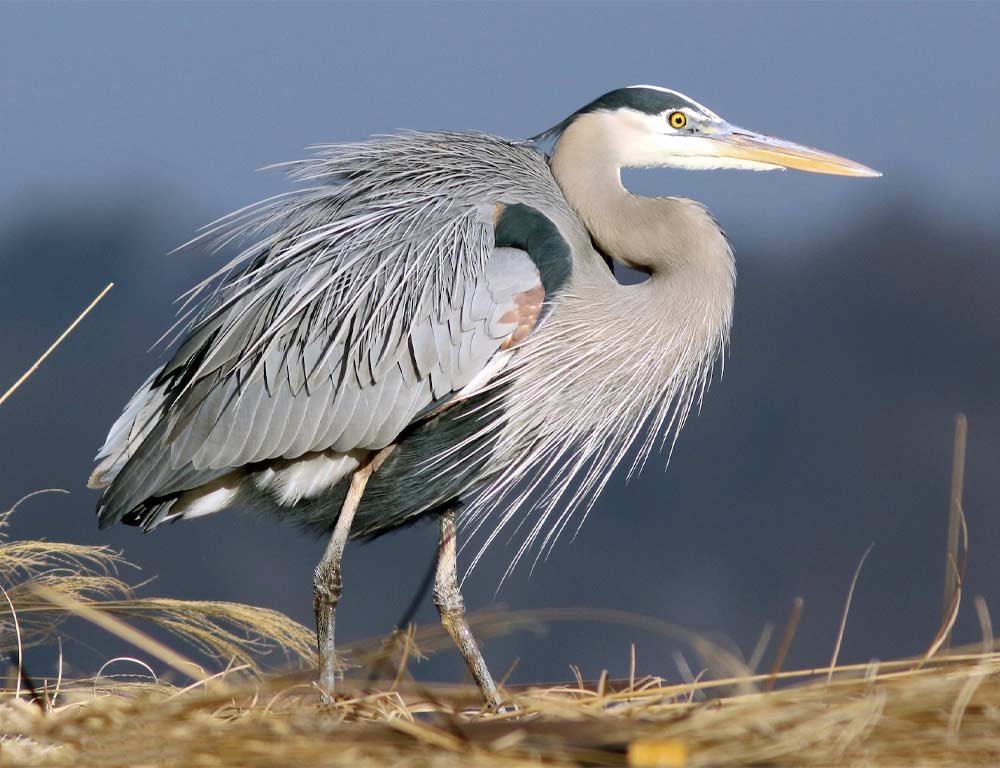
- Scientific name: Ardea herodias
- Category: wading bird
- Population: Increasing
- Life span: 15 years
- Size: 45-54 inches
- Weight: 5.5-7.9 pounds
- Food: fish, amphibians, reptiles, small mammals, and invertebrates
- Wingspan: 66-79 inches
- Status: least concern
The Great Blue Heron is a magnificent and iconic bird with its tall stature, long neck, and distinctive blue-gray plumage. This wading bird is commonly found in various aquatic habitats, including coastal areas, marshes, and ponds.
With a diet that includes fish, amphibians, reptiles, small mammals, and invertebrates, the Great Blue Heron employs a patient hunting strategy, standing motionless or moving slowly to stalk its prey.
Its impressive wingspan and adept flying skills contribute to its success as a widespread and adaptable species.
With an increasing population and a lifespan of up to 15 years, the Great Blue Heron is a key player in maintaining the ecological health of Florida’s diverse wetland ecosystems.
6. Little Blue Heron
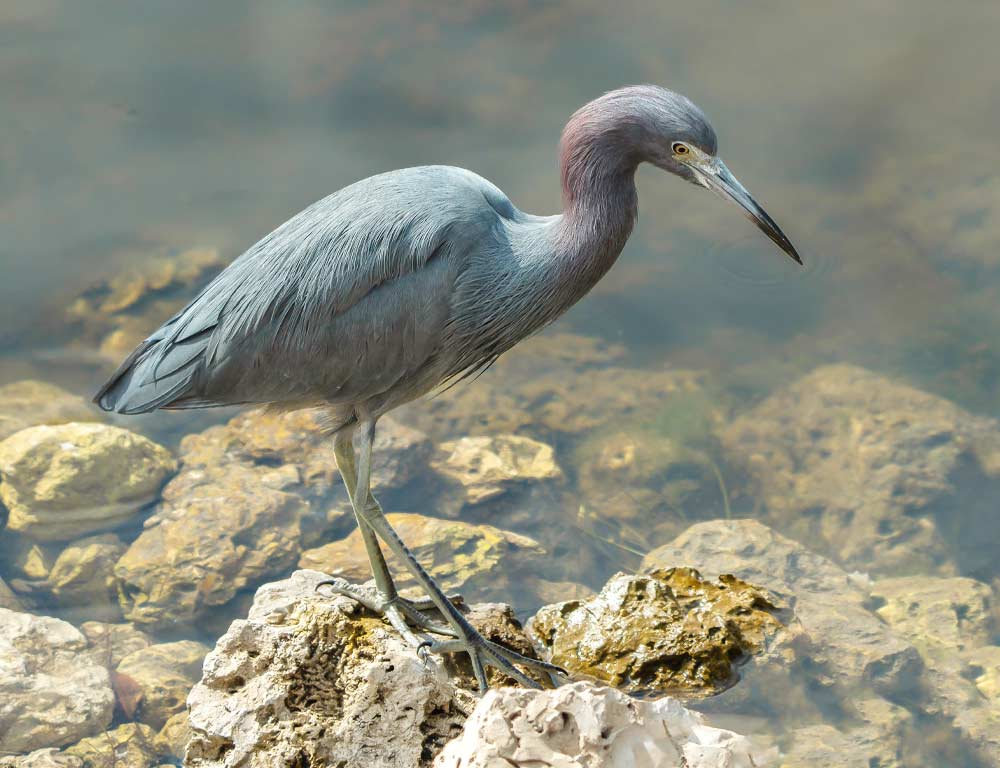
- Scientific name: Egretta caerulea
- Category: small heron
- Population: stable
- Life span: 7 years
- Size: 22-30 inches
- Weight: 0.5-1.5 pounds
- Food: fish, insects, crustaceans, and amphibians
- Wingspan: 36-39 inches
- Status: least concern
The Little Blue Heron is a striking bird with slate-blue plumage, often mistaken for the larger Great Blue Heron. This small heron is commonly found in shallow coastal waters, marshes, and wetlands. Its diet mainly consists of fish, insects, crustaceans, and amphibians.
The Little Blue Heron is known for its feeding strategy of slowly wading through water, using its sharp bill to capture prey with precise strikes. Despite its smaller size, it exhibits agility and efficiency in hunting.
With a stable population and a lifespan of up to 7 years, the Little Blue Heron contributes to the biodiversity of Florida’s coastal and freshwater habitats, showcasing the importance of small heron species in local ecosystems.
7. Snowy Egret
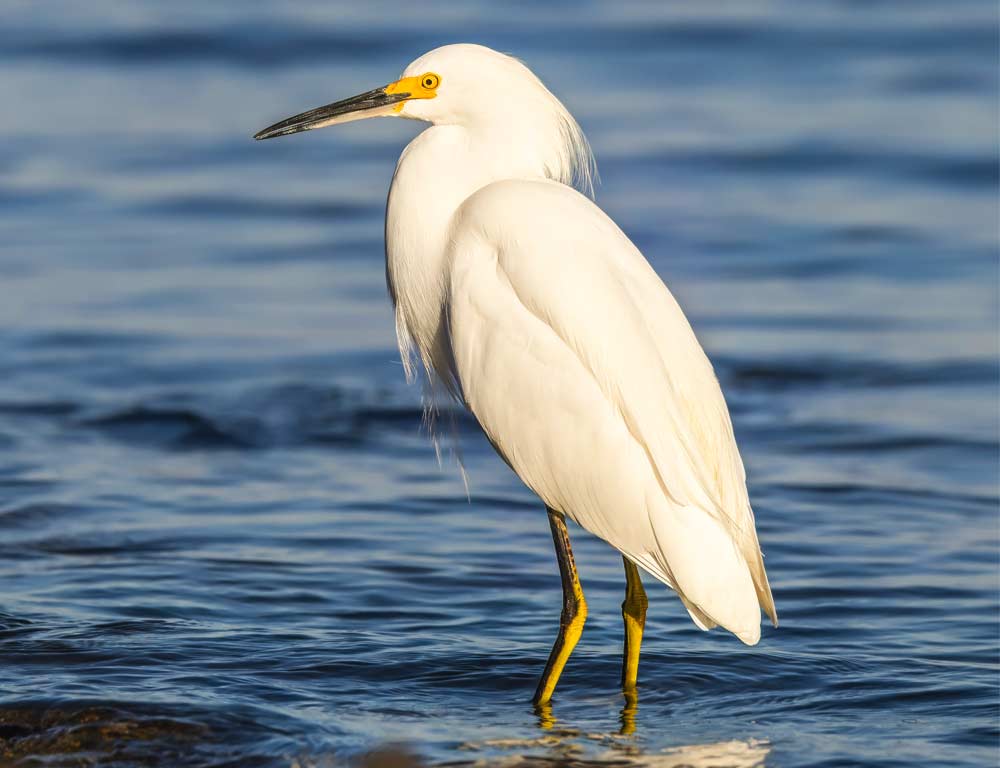
- Scientific name: Egretta thula
- Category: wading bird
- Population: Increasing
- Life span: 17 years
- Size: 22-26 inches
- Weight: 13-22 ounces
- Food: fish, crustaceans, insects, and amphibians
- Wingspan: 39-46 inches
- Status: least concern
The Snowy Egret is a graceful wading bird with striking white plumage, a slender black bill, and distinctive yellow feet. Found in a variety of coastal and inland wetland habitats, this egret employs a visually stunning hunting technique.
Its bright yellow feet stir up the water, startling and flushing prey into view, and then swiftly strikes with its sharp bill. With a diet that includes fish, crustaceans, insects, and amphibians, the Snowy Egret contributes to the health of wetland ecosystems.
With an increasing population and a lifespan of up to 17 years, this elegant bird is an essential component of Florida’s diverse avian community.
8. American Bittern
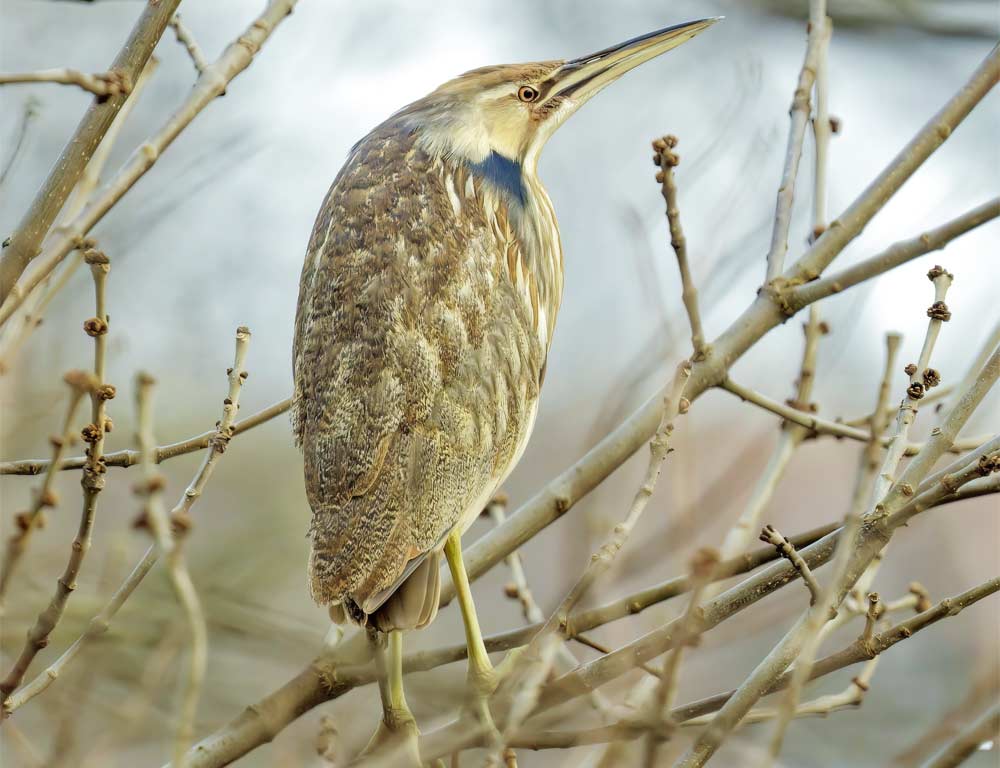
- Scientific name: Botaurus lentiginosus
- Category: heron
- Population: stable
- Life span: 10 years
- Size: 23-34 inches
- Weight: 1-2 pounds
- Food: fish, amphibians, insects, and small mammals
- Wingspan: 45-50 inches
- Status: least concern
The American Bittern is a well-camouflaged heron with mottled brown and buff plumage, blending seamlessly into its marshy surroundings.
Known for its distinctive booming call during the breeding season, the American Bittern is often elusive and difficult to spot. Its hunting strategy involves standing motionless, waiting for prey to approach, and then using its long bill to strike with precision.
With a diet consisting of fish, amphibians, insects, and small mammals, the American Bittern plays a vital role in maintaining the balance of wetland ecosystems.
With a stable population and a lifespan of up to 10 years, this heron is a testament to the adaptability and resilience of avian species in Florida.
9. Least Bittern
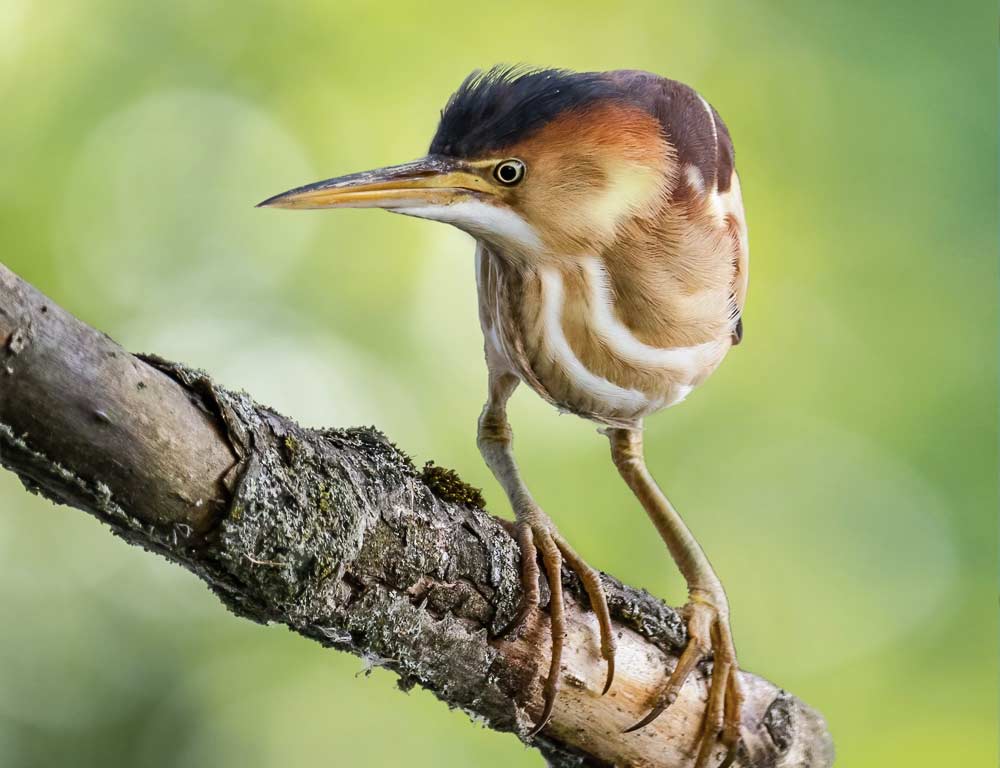
- Scientific name: Ixobrychus exilis
- Category: small heron
- Population: stable
- Life span: 7 years
- Size: 11-14 inches
- Weight: 2-4 ounces
- Food: small fish, insects, and amphibians
- Wingspan: 16-18 inches
- Status: least concern
The Least Bittern is a petite heron with a secretive nature, often concealed within dense vegetation in marshes and wetlands. Its plumage is a mix of brown, buff, and white, providing effective camouflage.
This small heron is known for its slow and deliberate movements, carefully navigating through dense vegetation in search of prey.
With a diet primarily consisting of small fish, insects, and amphibians, the Least Bittern is an essential component of the wetland food web. Despite its small size, it exhibits remarkable hunting skills, using its sharp bill to precisely capture prey.
With a stable population and a lifespan of up to 7 years, the Least Bittern contributes to the biodiversity and balance of Florida’s marsh and wetland ecosystems.
10. Yellow-crowned Night-Heron
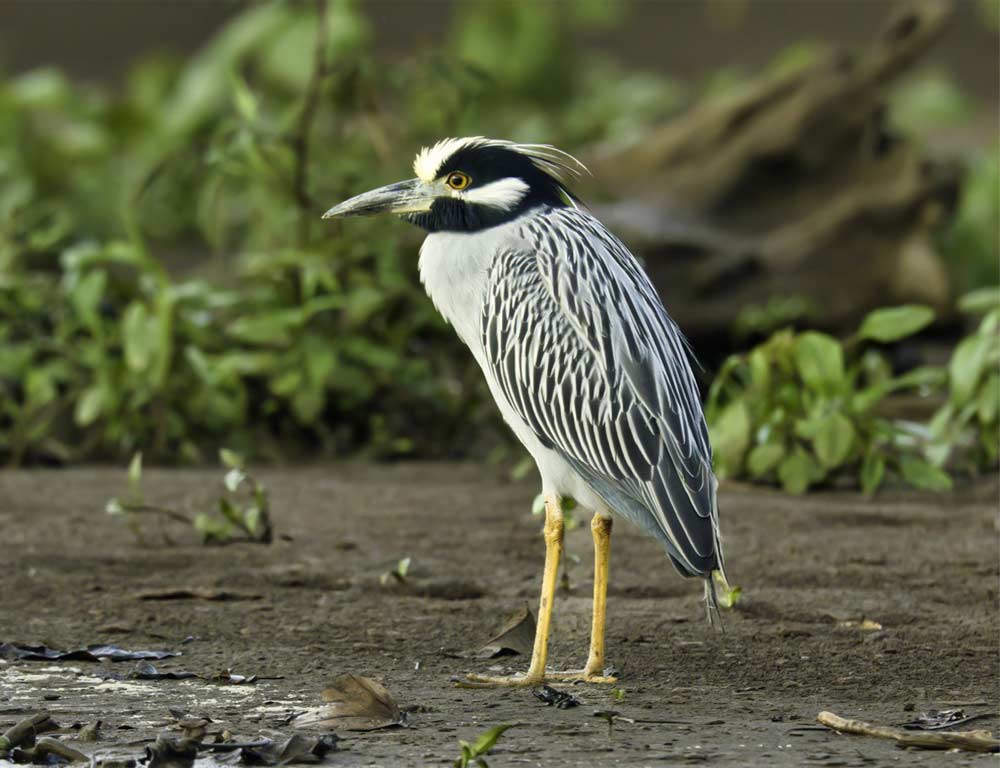
- Scientific name: Nyctanassa violacea
- Category: medium-sized heron
- Population: stable
- Life span: 10 years
- Size: 24-26 inches
- Weight: 1.5-2 pounds
- Food: crustaceans, fish, insects, amphibians, and small mammals
- Wingspan: 44-47 inches
- Status: least concern
The Yellow-crowned night heron is a distinctive heron species with a yellowish head and a black and white streaked body.
As the name suggests, it is often active at night but can also be seen during the day. It is commonly found in coastal and freshwater wetlands. Their diet includes crustaceans, fish, insects, amphibians, and small mammals.
They are known for their patient stalking and quick strikes when hunting. With a stable population and a lifespan of up to 10 years, the Yellow-crowned night heron contributes to the ecological diversity of Florida’s wetlands.
11. Tricolored Heron
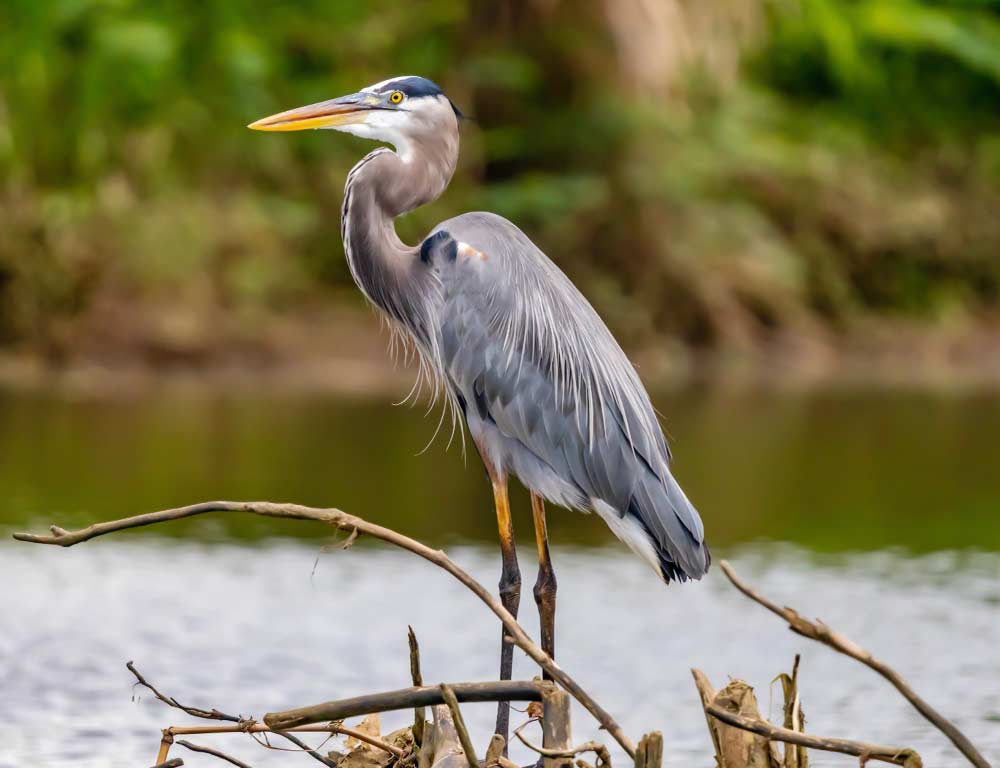
- Scientific name: Egretta tricolor
- Category: small heron
- Population: stable
- Life span: 9 years
- Size: 22-29 inches
- Weight: 11-18 ounces
- Food: fish, crustaceans, insects, and amphibians
- Wingspan: 35-41 inches
- Status: least concern
The Tricolored Heron is a striking bird with blue-gray plumage, a white belly, and a distinctive white stripe on its neck during the breeding season.
This small heron is often found in shallow coastal waters and marshes. Its feeding behavior involves agile movements and quick strikes to catch fish, crustaceans, insects, and amphibians.
The Tricolored Heron’s dynamic foraging style makes it an exciting bird to observe. With a stable population and a lifespan of up to 9 years, this heron contributes to the biodiversity and vibrancy of Florida’s coastal ecosystems.
12. Reddish Egret
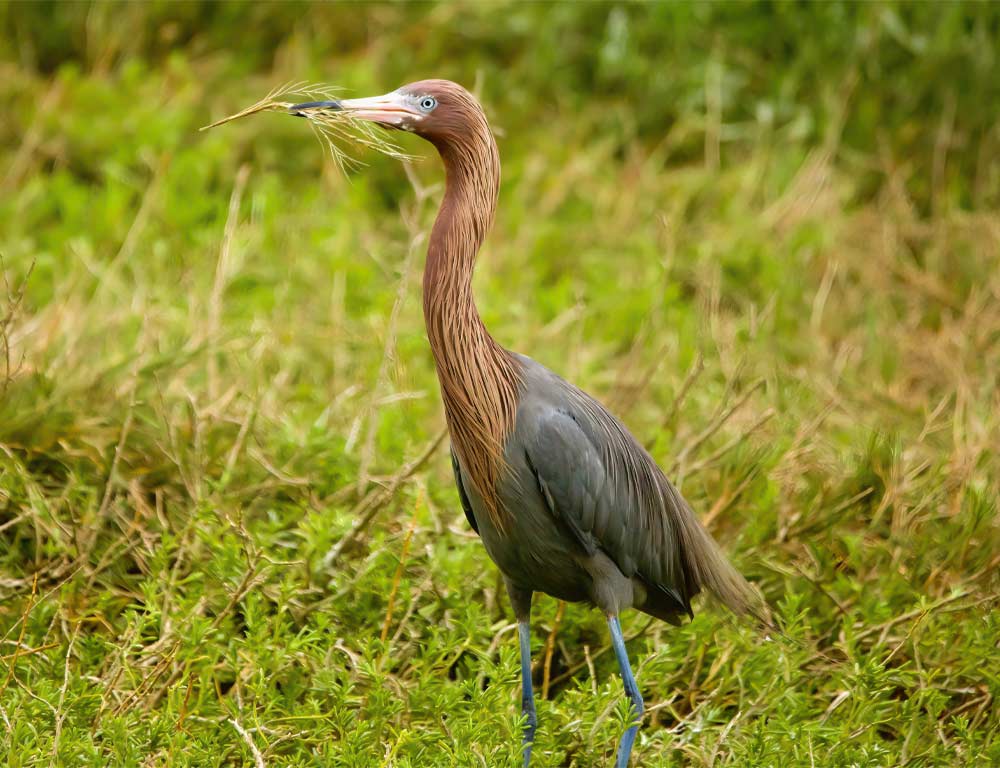
- Scientific name: Egretta rufescens
- Category: medium-sized heron
- Population: near-threatened
- Life span: 7-12 years
- Size: 26-32 inches
- Weight: 0.9-1.8 pounds
- Food: fish, crustaceans, and amphibians
- Wingspan: 41-46 inches
- Status: near-threatened
The Reddish Egret is a distinctive heron species with a reddish-brown neck and head during the breeding season. This medium-sized heron is often found in shallow coastal waters and estuaries.
Its feeding behavior is characterized by a unique dance-like foraging technique, where it runs, jumps, and spreads its wings to create shade, attracting fish into the shallows.
With a diet of mainly fish, crustaceans, and amphibians, the Reddish Egret faces threats such as habitat loss and human disturbance, leading to its near-threatened status.
With a lifespan of 7-12 years, conservation efforts are crucial to ensure the continued presence of this charismatic species in Florida’s coastal environments.
Where Are the Best Places in Florida to Herons?
Embark on a birdwatcher’s paradise in the Sunshine State as we unveil the best places in Florida to witness the majestic beauty of herons.
Florida offers a rich tapestry of habitats that beckon these elegant birds, from sprawling wetlands to coastal havens.
Here are some of the key locations where herons thrive, enchanting enthusiasts with their grace and vibrant presence.
Everglades National Park
Renowned for its vast wetlands and diverse ecosystems, the Everglades is a haven for herons.
An airboat tour through its waterways reveals the Great Blue Heron and Tricolored Heron gracefully navigating the marshes, providing a spectacular display for birdwatchers.
Ding Darling National Wildlife Refuge, Sanibel Island
Nestled on the Gulf Coast, this refuge is a hotspot for birding. The Reddish Egret and Little Blue Heron find sanctuary here, allowing observers to witness their unique foraging behaviors against the stunning backdrop of Sanibel’s coastal landscapes.
Merritt Island National Wildlife Refuge
Merritt Island is a birder’s paradise situated along Florida’s Atlantic Coast. Great Egrets and Snowy Egrets flourish in diverse habitats, providing a captivating spectacle for those exploring the refuge’s trails and waterways.
Corkscrew Swamp Sanctuary
A prime location for heron enthusiasts, Corkscrew Swamp Sanctuary boasts extensive cypress swamps. The Yellow-crowned night heron and American Bittern find solace here, adding a touch of mystery to the serene wetland setting.
J.N. “Ding” Darling National Wildlife Refuge, Captiva Island
Adjacent to Sanibel Island, Captiva offers a tranquil refuge for herons. Birdwatchers can spot the Cattle Egret and Green Heron in the tidal flats, showcasing the delicate balance between these birds and their coastal environment.
Wakodahatchee Wetlands
Nestled in Delray Beach, this urban wetland oasis is a hidden gem. Home to a diverse array of herons, including the Little Blue Heron and Black-crowned Night Heron, Wakodahatchee Wetlands provides a unique opportunity for close encounters with these graceful birds.
Wrapping Up
Herons gracefully weave their stories in the enchanting realm of Florida’s wetlands and coastal sanctuaries.
Each location we explored unveiled the intricate tapestry of their lives, from the iconic Great Blue Heron to the elusive Least Bittern. As stewards of diverse ecosystems, herons offer a glimpse into the delicate balance of nature.
These majestic birds paint vibrant strokes across Florida’s avian landscape, from the ethereal Everglades to the serene Corkscrew Swamp.
Embarking on a heron-centric journey captivates the senses and fosters a deeper appreciation for the interconnectedness of wildlife and habitat.
Florida’s herons are ambassadors of resilience and adaptability, inviting us to cherish and conserve the precious environments they call home. Best of luck.